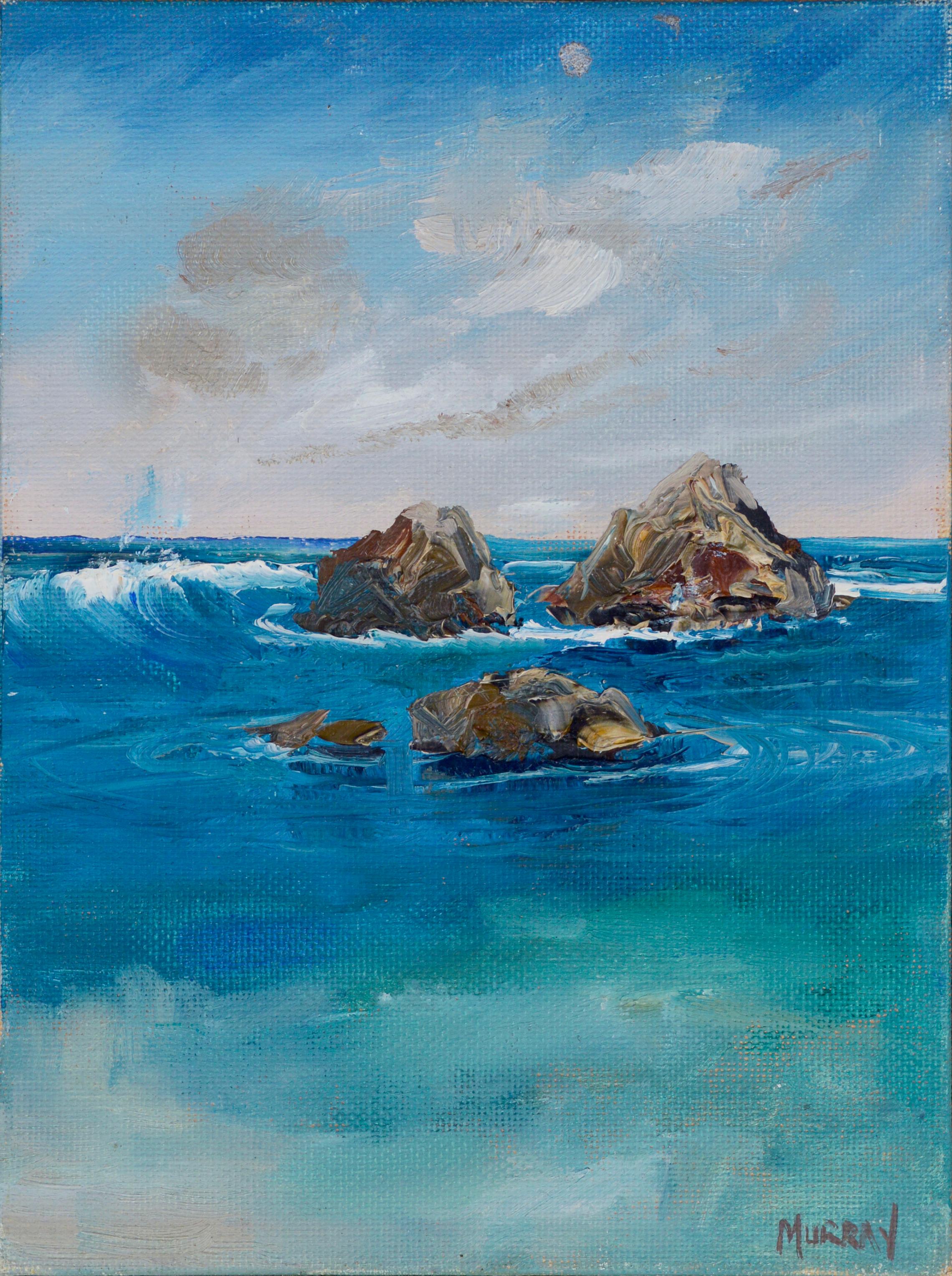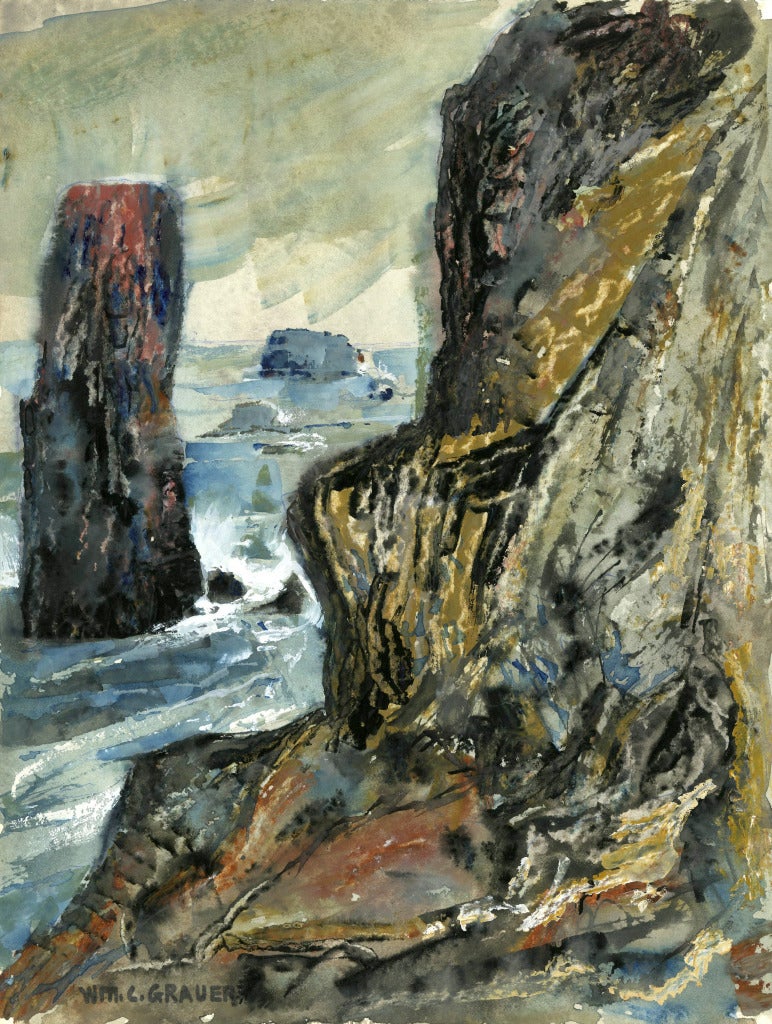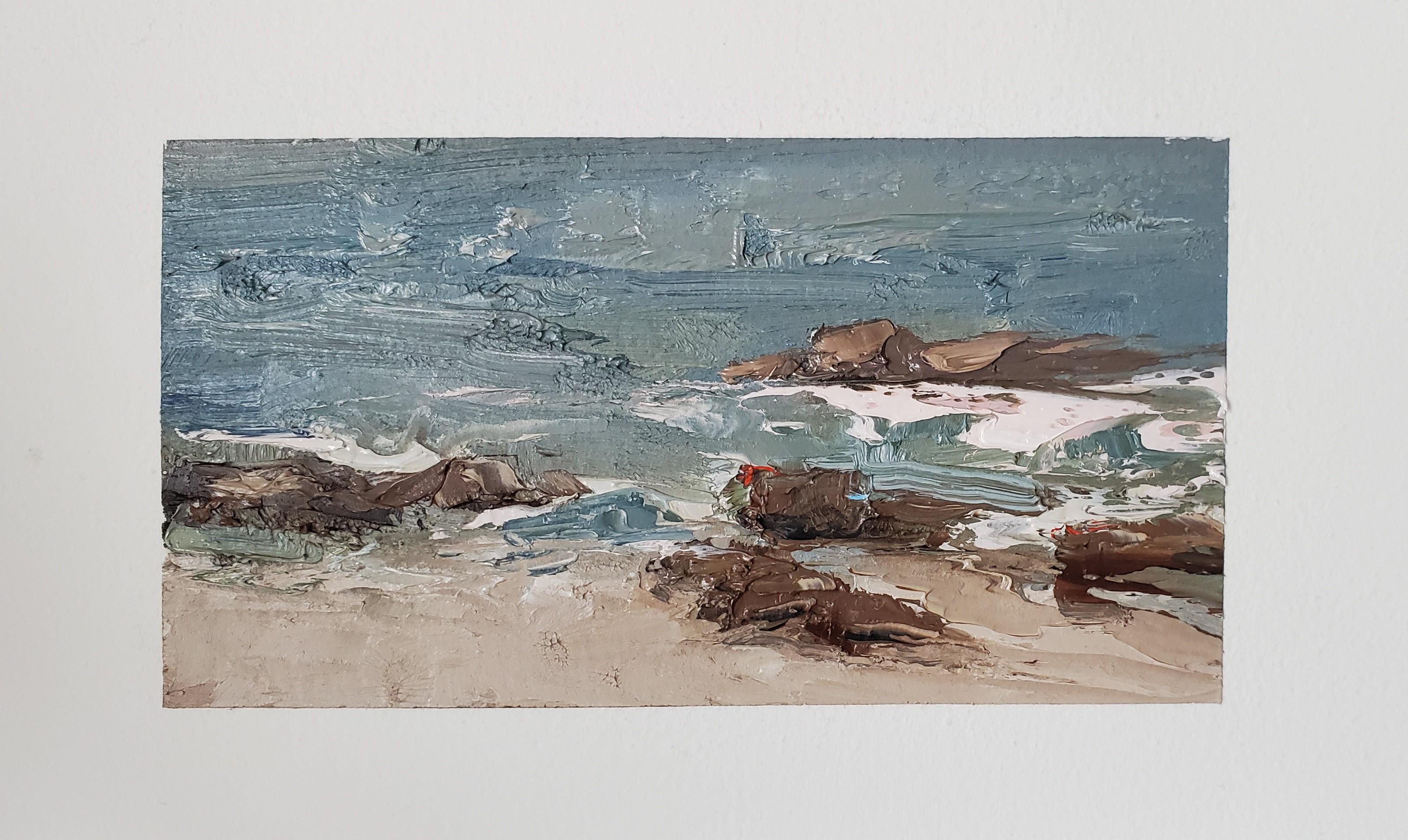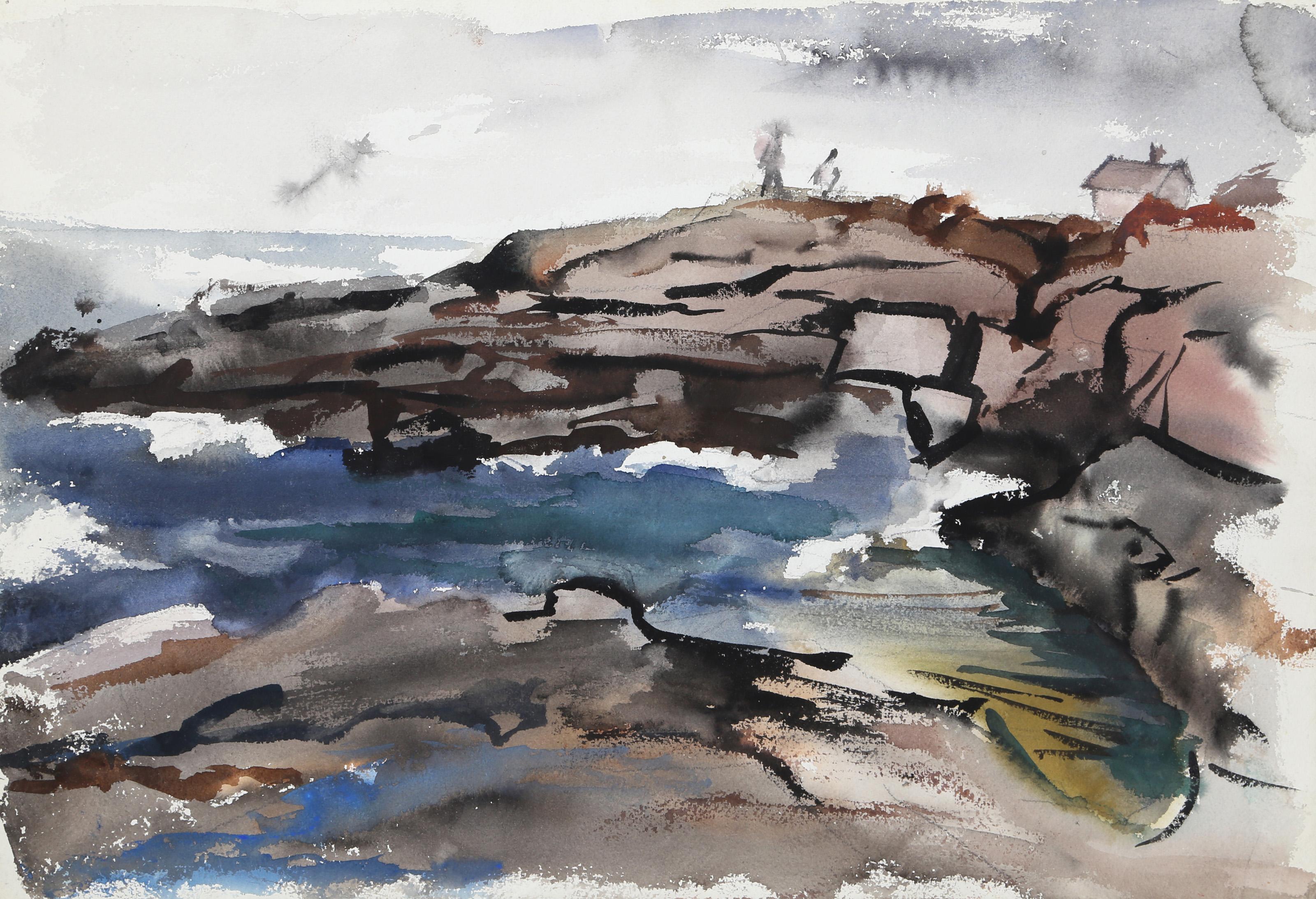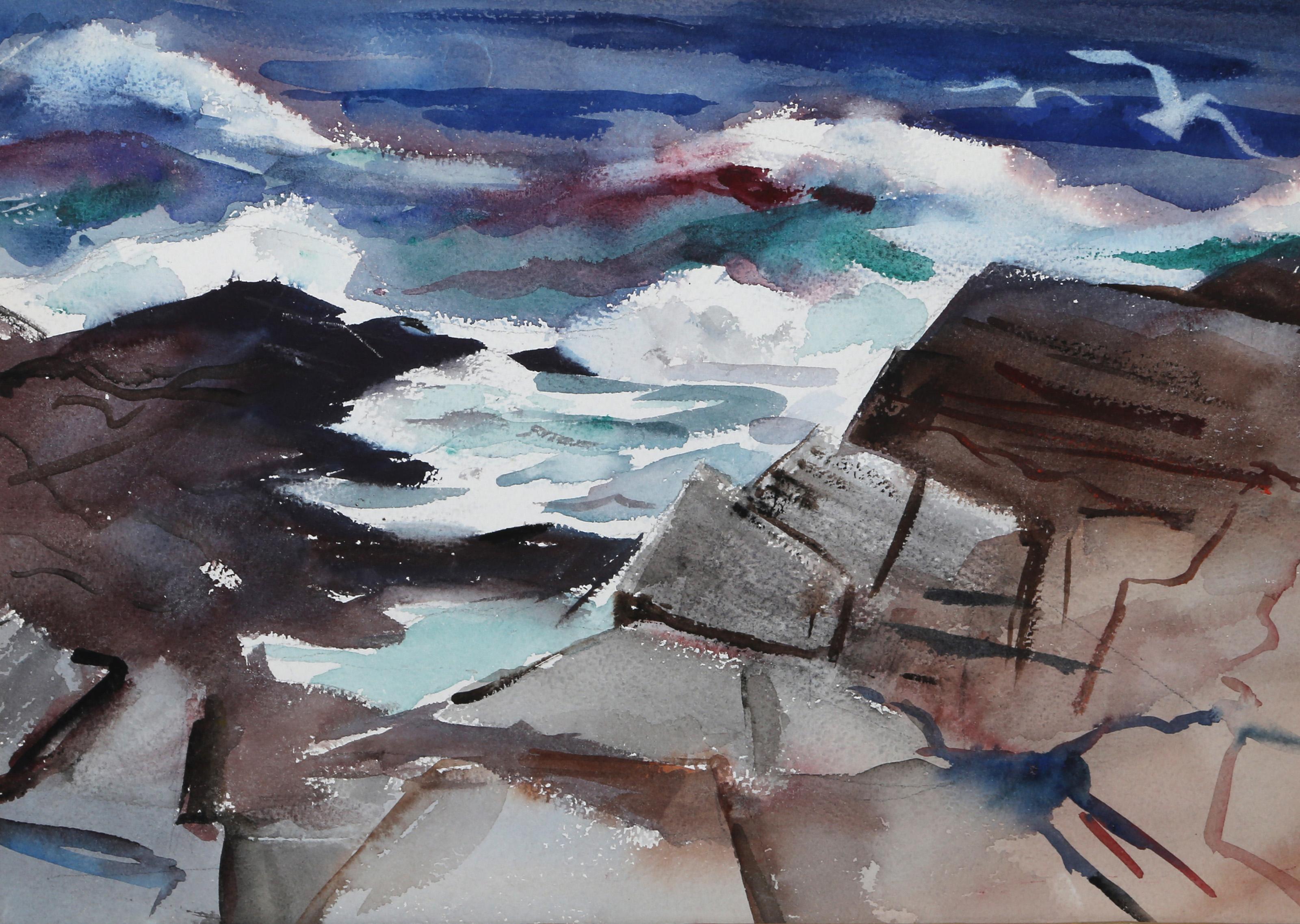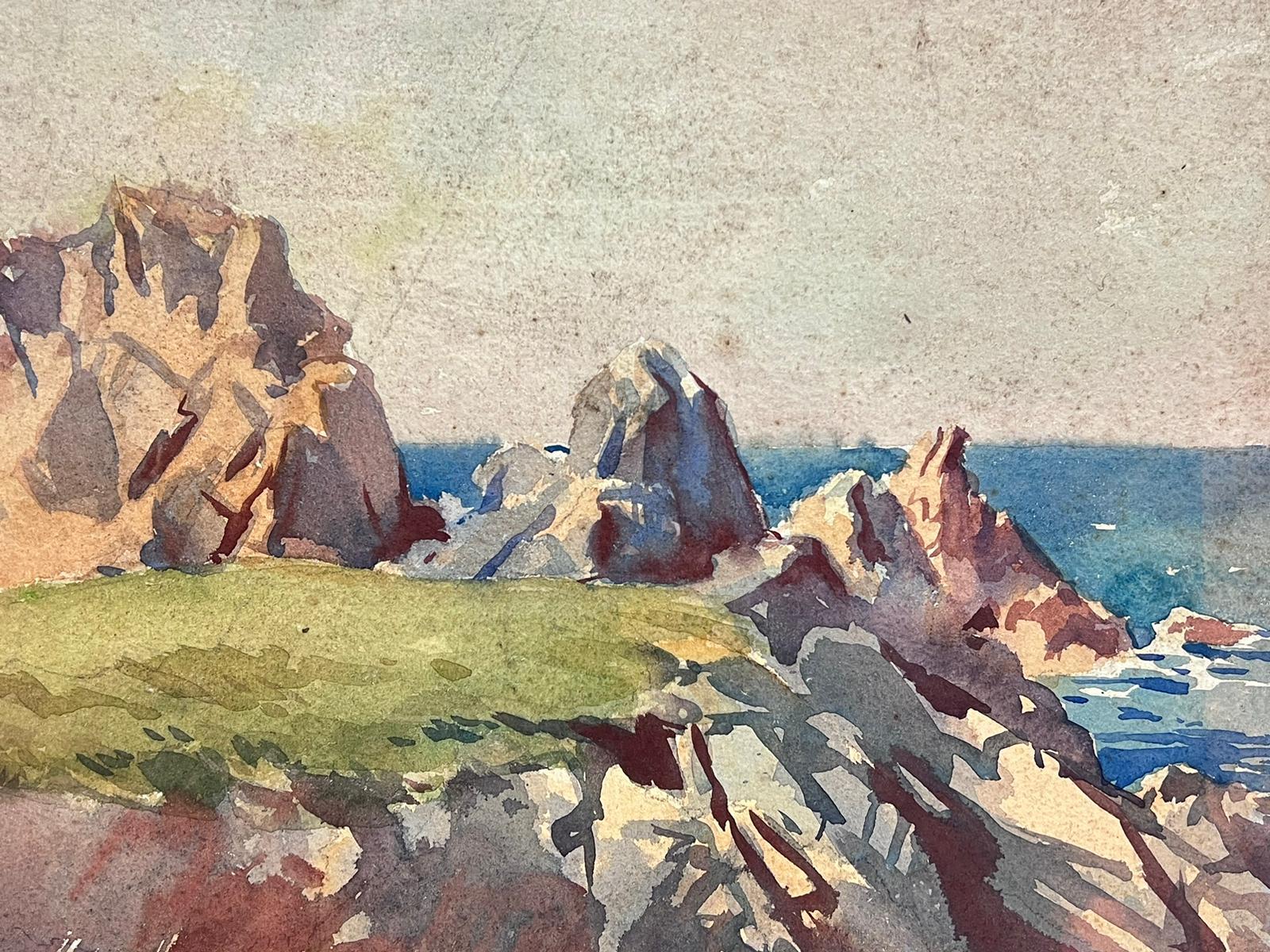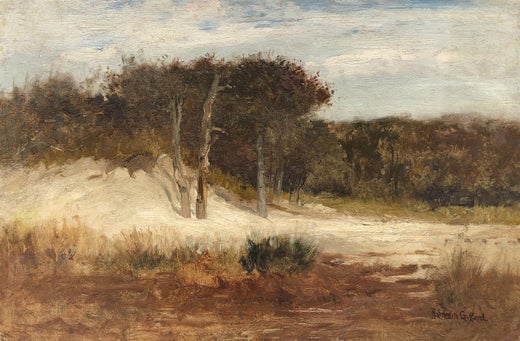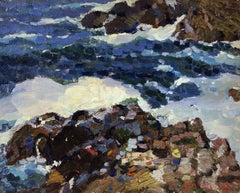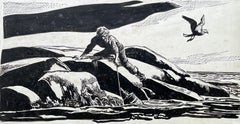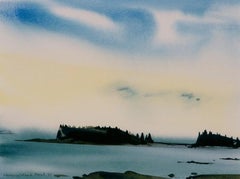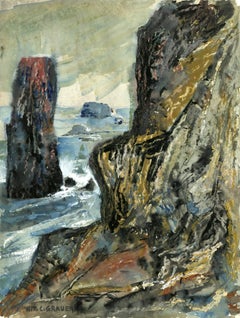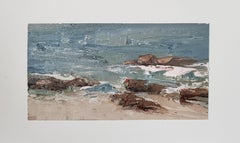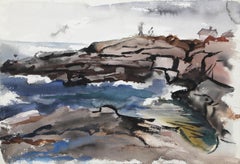Items Similar to Rocks and Sea
Want more images or videos?
Request additional images or videos from the seller
1 of 2
Robert Swain GiffordRocks and Sea
$2,500
£1,879.34
€2,178.75
CA$3,490.39
A$3,909.42
CHF 2,034.20
MX$47,479.64
NOK 25,788.50
SEK 24,333.38
DKK 16,256.58
Shipping
Retrieving quote...The 1stDibs Promise:
Authenticity Guarantee,
Money-Back Guarantee,
24-Hour Cancellation
About the Item
Born on a small island near Martha's Vineyard, R. Swain Gifford and his family moved to the New Bedford, Massachusetts, area when he was two years old. The Dutch marine painter Albert Van Beest arrived in New Bedford in 1854, providing the teenage Gifford with the opportunity of study; he collaborated with Van Beest on a number of ship pictures and in 1857 accompanied the senior artist when he moved to New York. Nevertheless, Gifford's limited financial resources soon forced him to return to New Bedford. Seven years later he opened a studio in Boston, where he produced romantic marine paintings and views of storm-tossed ships derivative of Van Beest and another New Bedford influence, William Bradford.
By late 1865 Gifford had moved back to New York, and there he befriended the older painter Samuel Colman. They shared interests in watercolor painting and etching and together were instrumental in founding the American Society of Painters in Water Color in 1867 and the New York Etching Club in 1878.
The 1870s were filled with travel for Gifford. He went to the West Coast in 1869 to execute illustrations for the poet William Cullen Bryant's book Picturesque America, visited Europe and North Africa in 1870-71 with Louis Comfort Tiffany, and made a more extensive European and North African sojourn in 1873-75 with his new wife, the artist Frances ("Fanny") Eliot. Gifford's travels abroad had a formative impact: he was exposed to the Oriental subject matter that immediately became a specialty and introduced to the Barbizon landscape style that characterized his later views of the New England coast.
In 1877 Gifford began an affiliation with the Cooper Union schools that lasted until his death; he gradually rose from the position of painting instructor to become art director of all the Cooper Union schools.
In later years Gifford divided his time between New York and a summer home in Nonquitt, Massachusetts. He also traveled extensively, going to Florida, Canada, and Europe, and accompanying the railroad magnate E. H. Harriman on his scientific expedition to Alaska in 1899. Gifford's interest in the relationship of art and science is documented in the Academy's library register; between 1867 and 1895 he checked out books on Goethe's theory of colors, on the anatomy of expression, and on the writings of Leonardo da Vinci.
Although he was an important figure in the Society of American Artists, serving as its vice-president (1878-79) and on its advisory board (1900-1901), Gifford was also devoted to the National Academy. A regular participant in the annual exhibitions from 1863, he also served on the Council from 1886 to 1889 and from 1902 until the year of his death. A memorial exhibition of Gifford's work was organized at the Century Association, New York, in 1905.
- Creator:Robert Swain Gifford (1840-1905, American)
- Dimensions:Height: 4.75 in (12.07 cm)Width: 14 in (35.56 cm)
- Medium:
- Movement & Style:
- Period:
- Condition:
- Gallery Location:Bryn Mawr, PA
- Reference Number:1stDibs: LU2773215829612
Robert Swain Gifford
Robert Swain Gifford (1840–1905) Robert Swain Gifford was an American landscape painter best known for his evocative coastal scenes and atmospheric landscapes. He was born on July 23, 1840, on Naushon Island, part of the Elizabeth Islands in Massachusetts. Early Life and Training Gifford moved with his family to New Bedford, Massachusetts, where he developed an early interest in art. He began formal training with Dutch artist Albert van Beest, who had a significant influence on his style, particularly in marine subjects. Travel and Influence Gifford’s artistic development was deeply shaped by extensive travel:
In the 1860s, he visited California, painting its rugged coastlines. He also traveled to Europe, North Africa, and the Middle East, producing works inspired by exotic and arid landscapes, which set him apart from many of his contemporaries. Style and Legacy Gifford’s work blends luminism and tonalism, focusing on mood, light, and atmosphere rather than intricate detail. He painted in both oil and watercolor, often capturing tranquil, meditative scenes of marshes, harbors, and deserts. His art reflects a fascination with natural light and subtle tonal variation, and he was especially adept at portraying foggy seascapes and remote coastal views. Career Highlights Elected full academician at the National Academy of Design in 1867.
Exhibited regularly at major institutions, including the Boston Art Club, the Pennsylvania Academy of the Fine Arts, and the Metropolitan Museum of Art.
Received a medal at the 1889 Paris Exposition Universelle. Death and Recognition Gifford died in 1905 in New York. Today, his works are held in prestigious collections including: The Metropolitan Museum of Art The Smithsonian American Art Museum
The Museum of Fine Arts, Boston
About the Seller
No Reviews Yet
Recognized Seller
These prestigious sellers are industry leaders and represent the highest echelon for item quality and design.
Established in 2001
1stDibs seller since 2024
Typical response time: 3 hours
- ShippingRetrieving quote...Shipping from: Bryn Mawr, PA
- Return Policy
Authenticity Guarantee
In the unlikely event there’s an issue with an item’s authenticity, contact us within 1 year for a full refund. DetailsMoney-Back Guarantee
If your item is not as described, is damaged in transit, or does not arrive, contact us within 7 days for a full refund. Details24-Hour Cancellation
You have a 24-hour grace period in which to reconsider your purchase, with no questions asked.Vetted Professional Sellers
Our world-class sellers must adhere to strict standards for service and quality, maintaining the integrity of our listings.Price-Match Guarantee
If you find that a seller listed the same item for a lower price elsewhere, we’ll match it.Trusted Global Delivery
Our best-in-class carrier network provides specialized shipping options worldwide, including custom delivery.More From This Seller
View AllRocks and Sea
By Paul Burlin
Located in Bryn Mawr, PA
Signed and dated lower right: Burlin 1914
Provenance
Private collection
Born in New York City, Paul Berlin was a Social Realist for most of his career, i...
Category
20th Century American Modern Landscape Paintings
Materials
Oil
July 25, Casco Bay
By Susan Headley van Campen
Located in Bryn Mawr, PA
July 25, Casco Bay
Watercolor on paper, 4 x 12 inches (10.2 x 30.5 cm)
Framed dimensions: 11 x 18 1/2 inches
Susan Van Campen’s plein-air oil paintings are painted with the confiden...
Category
21st Century and Contemporary Realist Landscape Drawings and Watercolors
Materials
Paper, Watercolor
Fisherman on the Rocks
Located in Bryn Mawr, PA
Born in Philadelphia, he became a nationally recognized cartoonist for his work with the "Evening Bulletin," a Philadelphia newspaper. In 1950, he had his own television show called ...
Category
20th Century Landscape Drawings and Watercolors
Materials
Ink
Northern Island, March 31st, Watercolor on Paper
By Susan Headley van Campen
Located in Bryn Mawr, PA
Titled lower left. Signed lower right: S. Headley Van Campen
Susan Van Campen’s plein-air oil paintings are painted with the confident brushwork of a watercolorist, achieving bold i...
Category
21st Century and Contemporary Contemporary Landscape Drawings and Waterc...
Materials
Watercolor
The Edge of the Forest
By Robert Swain Gifford
Located in Bryn Mawr, PA
Robert Swain Gifford (1840–1905)
The Edge of the Forest
Oil on canvas, 15 x 23 1/4 inches (38.1 x 59.1 cm)
Estate stamp lower right: RSwain Gifford
Provenance
The artist;
By descent in the family to the artist's great-grandaughter, until 2023
Born on a small island near Martha's Vineyard, R. Swain Gifford and his family moved to the New Bedford, Massachusetts, area when he was two years old. The Dutch marine painter Albert Van Beest arrived in New Bedford in 1854, providing the teenage Gifford with the opportunity of study; he collaborated with Van Beest on a number of ship pictures...
Category
19th Century Tonalist Landscape Paintings
Materials
Oil
Yellow Sky, Southern Island
By Susan Headley van Campen
Located in Bryn Mawr, PA
Yellow Sky, Southern Island
Watercolor on paper, 4 x 12 inches (10.2 x 30.5 cm)
Framed dimensions: 11 x 18 1/2 inches
Susan Van Campen’s plein-air oil paintings are painted with the...
Category
21st Century and Contemporary Realist Landscape Drawings and Watercolors
Materials
Paper, Watercolor
You May Also Like
Rocks in the Tide, Miniature Contemporary Coastal Seascape
By Kathleen Murray
Located in Soquel, CA
Vibrant miniature seascape by Kathleen Murray (American, b. 1958). Signed in lower right corner. Unframed. Image, 8"H x 6"W.
Kathleen Murray (American, b. 1958) was born in Los Ange...
Category
2010s American Impressionist Landscape Paintings
Materials
Canvas, Oil, Cardboard
untitled (Rocks along the Coast)
By William C. Grauer
Located in Fairlawn, OH
untitled (Rocks along the Coast)
Gouache and watercolor on paper, c. 1950
Signed with the estate stamp signature lower left (see photo)
This is a preliminary study for a large exhibition painting...
Category
1950s American Modern Drawings and Watercolor Paintings
Materials
Gouache
Rocks and Sea by Bethanne Cople, Oil on Paper Beach Landscape Painting
By Bethanne Kinsella Cople
Located in Atlanta, GA
The American landscape – endless skies, calming waters and the varied shores of the East and West coasts - are Cople’s passion and she travels far and wide to capture her subjects. “...
Category
21st Century and Contemporary Impressionist Landscape Paintings
Materials
Paper, Oil
Rocky Seascape, Impressionist Watercolor by Eve Nethercott
By Eve Nethercott
Located in Long Island City, NY
Eve Nethercott, American (1925 - 2015) - Rocky Seascape (P1.14), Year: 1957, Medium: Watercolor on Paper, Size: 15 x 22 in. (38.1 x 55.88 cm), Description: Looking out onto t...
Category
1950s Impressionist Landscape Drawings and Watercolors
Materials
Watercolor
Rocky Shore, Impressionist Watercolor by Eve Nethercott
By Eve Nethercott
Located in Long Island City, NY
Eve Nethercott, American (1925 - 2015) - Rocky Shore (P4.6), Year: circa 1960, Medium: Watercolor on Paper, Size: 13.5 x 18 in. (34.29 x 45.72 cm), Description: Looking out o...
Category
1960s Impressionist Landscape Drawings and Watercolors
Materials
Watercolor
Rocky English Coastline Sea British Mid 20th Century Impressionist Painting
Located in Cirencester, Gloucestershire
Frank Duffield (British, 1908-1982)
signed original gouache painting on paper stuck on board, unframed
size: 12 x 16 inches
condition: overall very good, minor wear to the edges as i...
Category
Mid-20th Century Impressionist Landscape Drawings and Watercolors
Materials
Gouache
More Ways To Browse
Marine Watercolours
Robert Holland
Antique Rose Drawing
Storm In The Sea
Alaska Landscape Art
Antique Vice
Watercolors North Africa
William A Cooper
African American 19th Century
Gifford Artist
Summer Storm
Da Vinci Drawings
19th Century American Etching
Dutch Watercolor 19th Century
Alaska Watercolor
Florida Antique Landscape
Da Vinci Etching
National Register Antique
